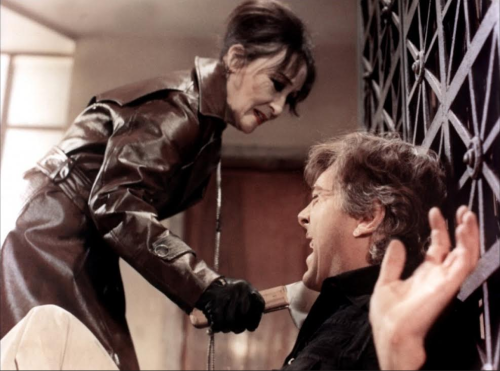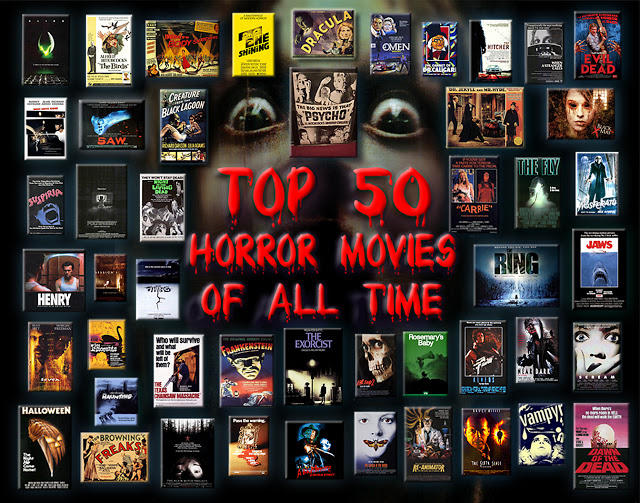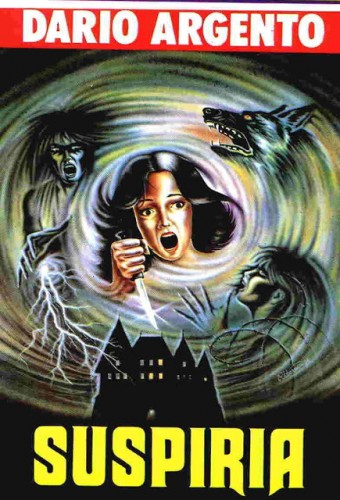This guest post by Kate Blair appears as part of our theme week on Violent Women.
Serial killer movies tend to follow a similar trope: An anonymous and monstrous killer stabs and disembowels his way through a panoply of victims until he faces off against one final, sweaty, and bloodied girl who escapes his clutches. At this point, the killer’s true identity is revealed, and he is overthrown – at least until the sequel. While we don’t necessarily know anything about the killer, we tend to assume this nameless menace is male. However, movies like Deep Red and Friday the 13th subvert viewer expectations when we ultimately find out the killer is not a man at all, but a woman – and a middle-aged one at that. Friday’s Mrs. Voorhees (Betsy Palmer) and the less celebrated Marta (Clara Calamai) from Deep Red reset the paradigm of the slasher genre and raise many interesting questions about gender as they do so.
To a certain extent, the reveal of woman as killer in both films comes across as a “gotcha” moment. After an hour or so of being scared out of your wits, it’s both surprising and puzzling to see a woman emerge as the killer. In the real world, most documented violent crimes are committed by men, but in a film, where anything can happen, there’s no reason to make this assumption. That’s why the gotcha-like reveal is also what makes these films so powerful. In shock, viewers think, “Why?” Then, after a moment’s reflection we think, “Why not?”
In one sense, female killers onscreen demonstrate women are just as capable of performing monstrosities as men are. Human beings frequently surrender to our darkest instincts. Women, of course, are no different. The murders these particular women commit are deeply disturbing, demonstrating women can be every bit as ruthless and dangerous as men – not just victims, but perpetrators as well.
Furthermore, female killers go against all the traits women are assumed to possess, such as passivity and weakness, and upend viewer expectations about femininity. We simply don’t expect murder from women, especially not the kind involving penetration and mutilation. It’s frightening, but at the same time, as a female viewer this moment is powerful because it’s rare for us to see ourselves reflected in such a persona.
There are a few widely accepted interpretations of slasher films (for these purposes, I’m considering Deep Red a slasher as well). As with all horror movies, critics focus on the audience’s response to the action on screen, which is often physical in addition to being emotional. In other words, the main reason audiences enjoy horror so deeply is that we get to enjoy watching victims being maimed in increasingly creative ways while our own entrails remain intact.
Slasher movies, especially Friday the 13th and Deep Red, also give viewers a chance to explore the fluidity of gender identity. Theorists like Linda Williams and Carol Clover contend slasher films allow the assumed male audience members to put themselves in the position of the female victim and empathize with her. Williams acknowledges female viewers obtain pleasure from of watching these movies as well, specifically in reacting to (and acting out) femininity.
These writers have also argued the main appeal of slasher films is the final girl who rises up and defeats her tormentor. She becomes increasingly resourceful and evades death, emerging unscathed from a massacre. Through this experience, she gains the active agency typically reserved for men on film. When women watch horror movies, we dabble in masculine traits by identifying with this final girl. However, it’s rare that we get to try on the role of killer.
Viewers, both male and female, identify with the victims on screen, but there are moments where we also experience the killer’s perspective. These films are set up so there are sequences where subjective camera work places us in the point of view of the murderer. In Friday the 13th we see the counselors as their stalker sees them, stabbing and slicing with careful deliberacy. In Deep Red, viewers also witness brutal acts through the killer’s eyes. In one instance, the anonymous figure simultaneously drowns a victim and scalds her face with hot water.
We assume this perspective is male, not only because of the actions being committed, but also because viewers always assume a male point of view in cinema, whether or not we realize it. The camera’s gaze looks, the female body is looked at. In some ways, it would be a shock to find we had been seeing through the eyes of a woman, no matter what she was doing. In this case, it’s even more unexpected.
For Dario Argento in particular, violent women are a bit of a fixation, even dating back to his first film, The Bird with the Crystal Plumage. The killer in this classic giallo also turns out to be a woman. A previous victim of a violent crime, a gallery owner named Monica becomes a psychotic killer after coming in contact with a piece of art depicting a similar event. Rather than reliving the memory of her victimhood, she instead identifies with the knife-wielding killer and goes on to commit similar acts.
Deep Red also sets up a question of gender roles early on by invoking a screwball comedy-like sparring between Marcus Daly (David Hemmings) and Gianna Brezzi (Daria Nicolodi), the journalist he works with to solve the case. She has some masculine characteristics; he has some feminine ones. He is a sensitive artist (a pianist), and she is a career woman. He notes it’s a simple fact that men are stronger than women. In response, she challenges him to arm wrestle. She wins twice, and naturally, he accuses of her of cheating. Despite these power plays with his accomplice, it never seems to cross his mind that his invisible sparring partner, the killer, might also be a woman.
In Deep Red and Friday the 13th, Mrs. Voorhees and Marta both make an appearance before they are unveiled as the killers, but neither of them is suspect. Both appear harmless to characters who cross their paths, which likely has something to do with the fact that both killers are middle-aged women. Daly even spots Marta at the scene of the crime, but believes what he saw was only a painting. He is distressed when it seems to disappear. She shows up again some time later when Daly goes to his friend’s apartment hoping to track him down. Instead he finds Marta, who also happens to be his friend’s mother. Daly later discovers “the painting” he saw was Marta’s reflection in the mirror – underlining the idea that he simply doesn’t see her at all.
In Friday the 13th, viewers don’t actually witness the iconic Mrs. Voorhees’ face until the final act, but we do see various campers’ reactions to her. In each case, the campers appear relieved to have come across her. The first victim, Annie (Robbi Morgan), late to her first shift in the kitchen, flashes a dopey grin as she asks for a lift to the camp ground. Similarly, after being barricaded in her cabin and terrorized by the psychopathic killer, Alice (Adrienne King) is deeply relieved when Mrs. Voorhees approaches. Alice even goes so far as to embrace her apparent savior. None of the campers seem the slight bit distressed by Mrs. Voorhees’ appearance. In a turtleneck with dyed, bobbed hair, Mrs. Voorhees appears a maternal figure, but the psychotic glint in her eyes reveals she’s anything but.
Mrs. Voorhees and Marta don’t look like we expect killers to look. As middle-aged women, they appear maternal – more likely to sit you down, feed you cookies and tell you everything will be all right. However, in this case, making assumptions based on appearance is particularly deadly. Older women are often overlooked. As murderesses, Marta and Mrs. Voorhees lend a sense of power and vitality to this demographic. These women seek their revenge on the youth who consider them obsolete, or nurturing figures who exist to support the young people’s story. To play an active role in their own narratives, these women take up the knife.
There are many enjoyable aspects of watching horror movies. Viewers get to toe that fine line of being scared and being exhilarated without fear of actual injury. We also get to float between identification with victims and killers. While we are in the safe space of cinematic imagination, it’s not wrong step out of the role of victim and instead, into that of a killer. As Monica discovers in Bird with the Crystal Plumage, being a victim (however resourceful) grows tiresome after a while. Simultaneously, as maternal figures, Mrs. Voorhees and Marta remind us that women don’t fade to the background with age, and male gender traits don’t belong to men alone.
It’s exhausting to be victimized – first babied and objectified, then cast aside when we are too old to be considered objects of lust. It’s frustrating to be perceived as passive rather than an active force, a person who makes her own choices, however evil they may be. Horror movies have always allowed women to explore their masculinity, and inhabiting the role of killer is an extension of that playfulness. Female killers like Marta and Mrs. Voorhees strike down gendered assumptions, one gruesome murder at a time.
Kate Blair enjoys writing about film and feminism. She currently resides in Chicago with her wife, cat, dog, and a bowl of pasta. You can find more of her scribblings on her blog Selective Viewing or follow her on Twitter @selective_kate














